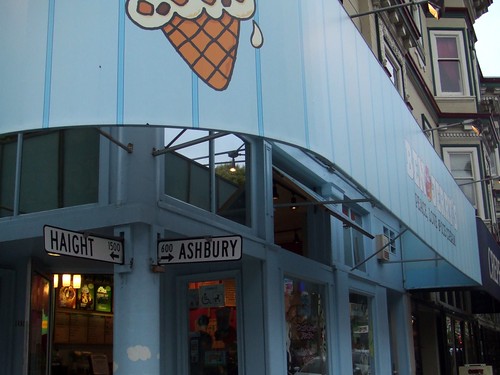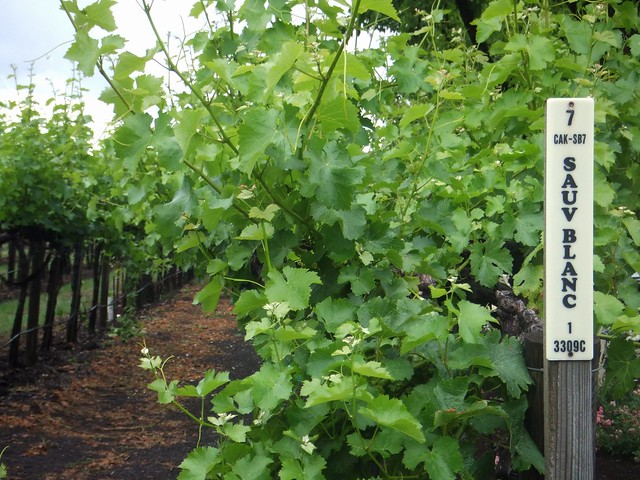I recently returned from a 6-day trip to California (you may remember my preparations) that turned out to be surprisingly eco-friendly, and so I thought I would deviate from the traditional blog post today to do a sort of photo-essay. Hopefully this will help drive home the point that no matter where you are going or what your budget, you can find ways to be eco-friendly. And of course not everything you do is going to be environmentally sound, but whatever you can do that is eco-friendly is a good start.
 Use local and/or mass transportation when possible
Use local and/or mass transportation when possible
Take the metro (or, in San Francisco, the BART), take a bus, take a trolley, even take a taxi! Taking mass transit reduces your carbon footprint, and using local transportation instead of a rental car helps to ensure your tourist dollars stay in the area. The San Francisco cable cars, for example, are almost exclusively patronized by tourists, and since they are part of the San Francisco Municipal Transportation Agency the tourist revenue goes to the city. This cable car system is also the world’s last manually operated cable car system, and it has been in use since 1873; it is historic, as well as carbon-footprint reducing. Unfortunately, the cable cars were not operating the day we were in the city, and we couldn’t figure out why—or even get a picture of one, hence the picture of the cable car safety tips (which we did find pretty entertaining).
 Eat local and organic whenever possible.
Eat local and organic whenever possible.
Ben & Jerry’s was one of the first chains to popularize “all-natural” foods (though there has been a bit of controversy over whether or not their products can truly be labeled “all-natural,” but that’s a conversation for another day), and continues to be involved in environmental movements. The company has launched protests against Arctic oil drilling, for example, as well as the use of products from cloned animals. Of course, in a place like California it’s not hard to find restaurants that are much better examples of eco-friendly dining than Ben & Jerry’s—I just didn’t take any pictures of them. Most of the restaurants we ate at during our 6-day stay used locally grown/farmed ingredients, and they were delicious! Mustard’s Grill in Napa, for example, gets 20% of its produce from its 2-acre organic garden, and my steak at Pearl Restaurant came from the nearby Five Dot Ranch, which provides hormone-free beef to much of the area.  Gott’s Roadside (formerly Taylor’s Refresher) is a local institution that gets its beef from another local ranch that provides vegetarian-fed beef with no added antibiotics or growth hormones, and the chicken is also locally grown, free range, and vegetarian-fed. California may be exceptional in the number and variety of restaurants committed to using sustainable farming and organic products, but I’m certain that no matter where you go you can find at least one restaurant that uses locally grown ingredients or hormone-free meats—even if it’s Ben & Jerry’s.
Gott’s Roadside (formerly Taylor’s Refresher) is a local institution that gets its beef from another local ranch that provides vegetarian-fed beef with no added antibiotics or growth hormones, and the chicken is also locally grown, free range, and vegetarian-fed. California may be exceptional in the number and variety of restaurants committed to using sustainable farming and organic products, but I’m certain that no matter where you go you can find at least one restaurant that uses locally grown ingredients or hormone-free meats—even if it’s Ben & Jerry’s.
 When looking at grapevines you might be tempted to think of the massive amount of water necessary to sustain them. There are well over 400 vineyards in Napa Valley alone, each with acres and acres of grapes, so surely a colossal amount of water must be used every day, especially in a state as dry as California, right? Wrong. We were surprised to learn that most vineyards practice dry harvesting, which requires no water besides rainfall. Dry harvesting produces a much more flavorful grape, which in turn produces a more flavorful and complex vintage. Watery grapes, like the kind you buy at the store, are produced when the vines are watered, and they do not make good wine. So, wine-making turned out to be much more eco-friendly than we thought, even when the grapes aren’t grown organically and pesticide-free, and we felt a lot less guilty about our love of wine!
When looking at grapevines you might be tempted to think of the massive amount of water necessary to sustain them. There are well over 400 vineyards in Napa Valley alone, each with acres and acres of grapes, so surely a colossal amount of water must be used every day, especially in a state as dry as California, right? Wrong. We were surprised to learn that most vineyards practice dry harvesting, which requires no water besides rainfall. Dry harvesting produces a much more flavorful grape, which in turn produces a more flavorful and complex vintage. Watery grapes, like the kind you buy at the store, are produced when the vines are watered, and they do not make good wine. So, wine-making turned out to be much more eco-friendly than we thought, even when the grapes aren’t grown organically and pesticide-free, and we felt a lot less guilty about our love of wine!
Michelle Bovée is a SISGI Group Program and Research Intern focused on international affairs, economic development, and responsible tourism. To learn more about the SISGI Group visit www.sisgigroup.org



1 pings